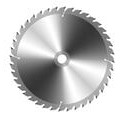

Small circular saw blades (12 inches and under) are one of the most common woodworker's and carpenter's tools. Table saws, radial arm saws, power miter saws, skil saws, they're found everywhere. These days, everyone needs to get as much mileage out of their circular saw blades as possible, but how do we know which circular saw blades are worth the expense of sharpening, setting, or repairing?
Overheated: Any circular saw blade that shows signs of having been overheated needs to be junked immediately. Blueing or other discoloration on the blade that can't be removed is a dead giveaway. Overheated blades can lose their temper (no, that doesn't mean they get mad), making the steel soft and weak, possibly resulting in catastrophic blade failure.
Damaged: Cracks, chips, arbor hole worn overlarge are all signs of blade damage and could cause the blade to fail catastrophically.
Excessive rust: Deterioration caused by pitting from excessive rust can also degrade a circular saw blade's structural integrity and could cause the blade to fail catastrophically.
Warpage: Any blade that is significantly out of true vs a straight edge should be dumped. Warped blades will result in rough cutting or extreme vibration. Warped blades are usually the result of overheating or being tweaked by hitting metal in the wood being cut.
Eroded: Teeth that are eroded significantly out of shape from rust or wear are a definite sign the blade needs to be deep sixed.
Overheated: Teeth that are discolored have probably been overheated from abuse. These teeth may become ridiculously hard, leading to broken (and flying) teeth or a circular saw blade that is entirely impossible to sharpen, since the normal files won't touch the hardened teeth.
Missing: Missing teeth will result in a rough cutting blade or a blade that vibrates because it's out of balance.
Missing carbides: A missing carbide from a circular saw blade will also result in a rough cutting blade or a blade that vibrates because it's out of balance. The missing carbide also leaves the blade attempting to cut with the bare steel tooth, resulting in tooth damage. Carbides can be replaced but it's rarely economical to do so. Missing carbides usually result from hitting metal objects in the wood being cut.
Contaminant buildup: Circular saw blades may build up crud on their sides, usualy glue from plywood or panelling or melted plastic from cutting plastic or PVC. Excess build up that can't be removed (melted plastic) can result in vibration and rough cutting.